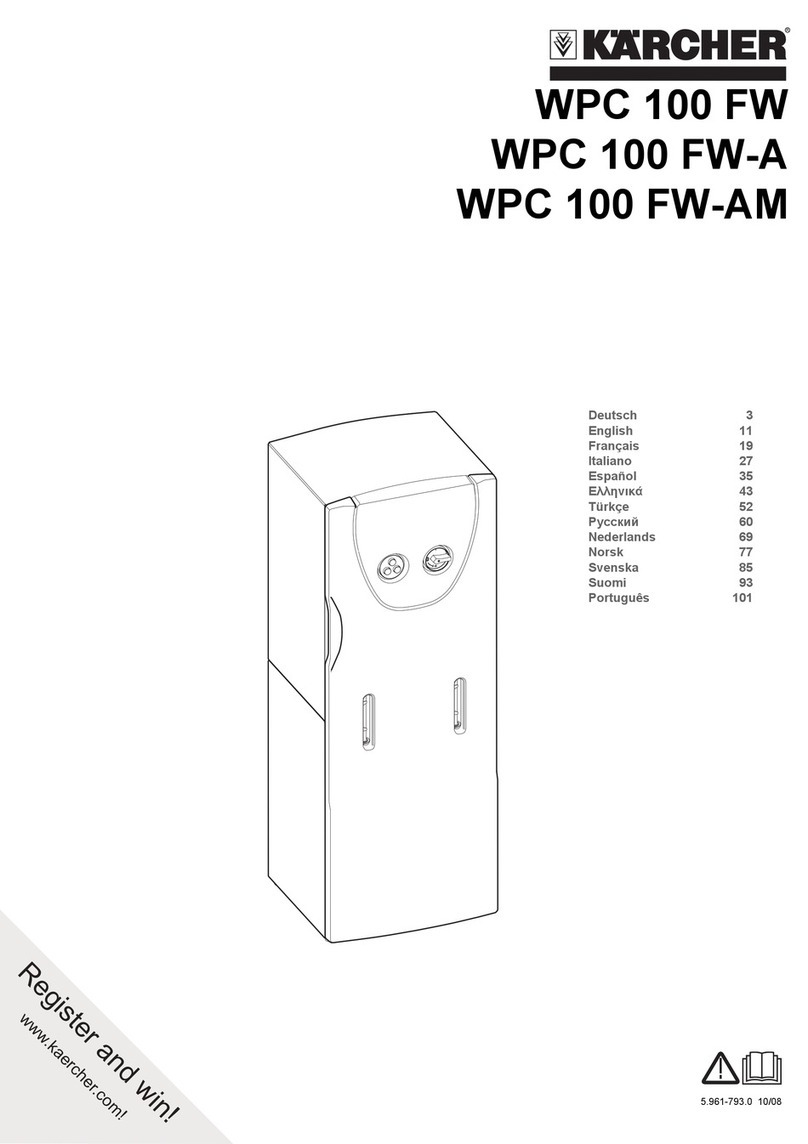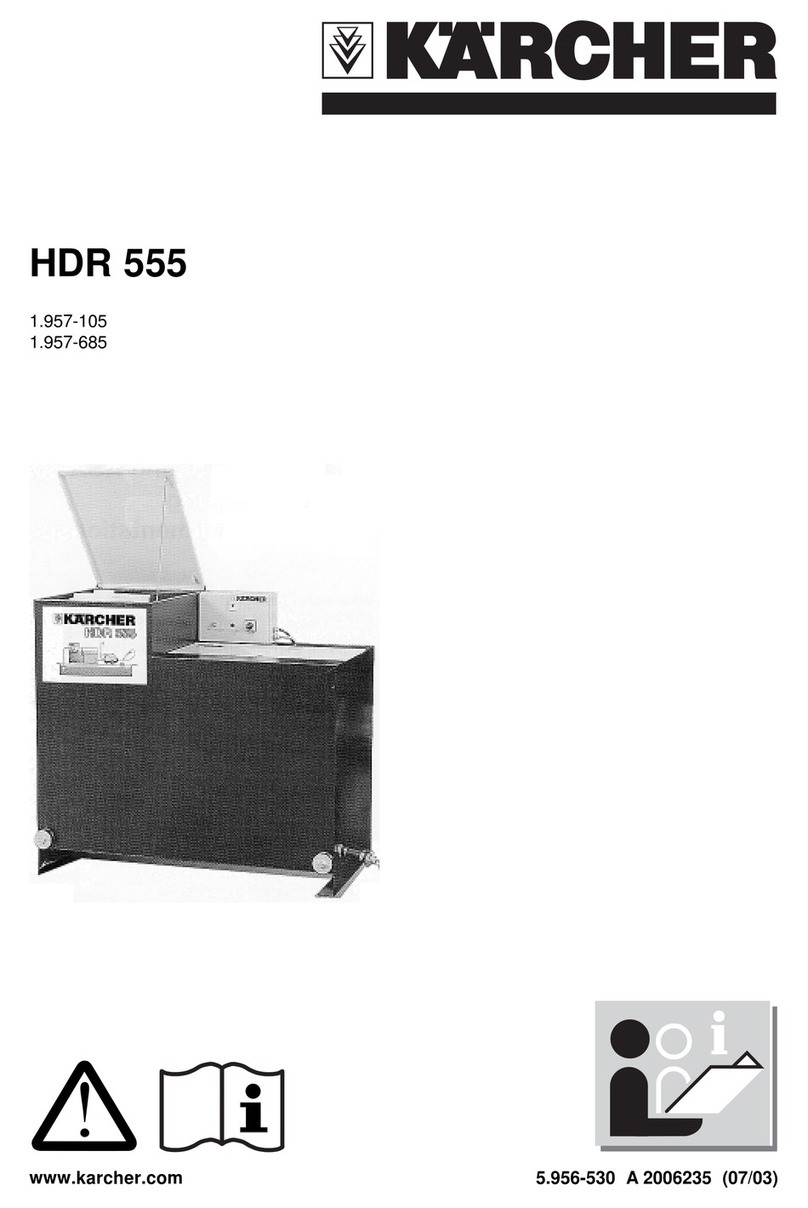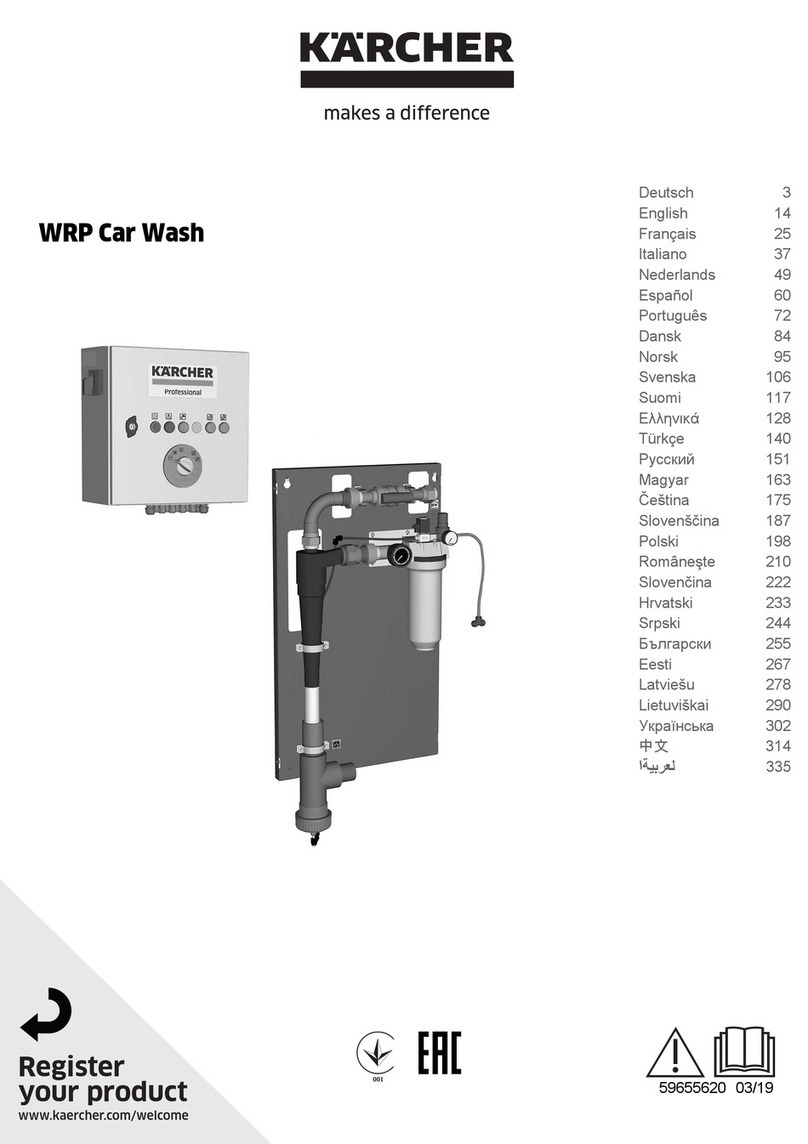
6 Deutsch
ÎAnlage mit Taste „ON/OFF“ ausschal-
ten.
ÎRohwasserzufuhr unterbrechen.
ÎAnlage mit Taste „ON/OFF“ kurz ein-
schalten, bis sich der Druck am Vorfil-
ter abgebaut hat.
ÎAnlage mit Taste „ON/OFF“ ausschal-
ten.
ÎFilterschlüssel am Filtertopf ansetzen
und Filtertopf abschrauben.
ÎFiltereinsatz aus dem Filtertopf her-
ausnehmen und neuen Filtereinsatz in
den Filtertopf einsetzen.
ÎDichtring auf Beschädigung untersu-
chen und gegebenenfalls ersetzen.
ÎFiltertopf anschrauben und mit dem
Filterschlüssel festziehen.
ÎRohwasserzufuhr wiederherstellen.
ÎAnlage mit Taste „ON/OFF“ einschal-
ten.
몇Warnung
Beschädigungsgefahr für die Anlage. Bei
Veränderungen der Anlageneinstellungen
dürfen folgende Werte nicht überschritten
werden:
–Pumpendruck maximal 7 MPa
–Trinkwassermenge maximal 600 l/h
–Konzentratmenge mindestens 1200 l/
h
Hinweis
Die Anlage reagiert zeitverzögert auf Än-
derungen am Regelventil. Deshalb die
Einstellung am Regelventil nur in kleinen
Schritten durchführen und die jeweilige
Auswirkung abwarten.
(1) Trinkwasserfluss von _____ l/h auf
_____ l/h gesunken
1 Druckregelventil
2 Durchflussmesser Trinkwasser
ÎTrinkwassermenge am Durchfluss-
messer Trinkwasser ablesen und mit
dem Wert bei Inbetriebnahme verglei-
chen (siehe Inbetriebnahmeprotokoll).
Ist der Trinkwasserfluss auf _____l/h
gesunken, nachstehende Feinregulie-
rung durchführen:
ÎDruckregelventil langsam im Uhrzei-
gersinn schließen, bis am Durchfluss-
messer Trinkwasser die Sollmenge
erreicht ist.
Hinweis
Führt die Feinregulierung zu keiner Erhö-
hung des Trinkwasserflusses, ist der
Kärcher Kundendienst zu verständigen.
(2) Leitfähigkeit des Trinkwassers von
_____µS/cm auf _____µS/cm gestiegen
Hinweis
Kleine Erhöhungen der Trinkwasserleitfä-
higkeit beeinträchtigen die Trinkwasser-
qualität nicht.
ÎAktuellen Leitwert im Display des Be-
dienfeldes ablesen und mit dem Wert
bei Inbetriebnahme vergleichen (siehe
Inbetriebnahmeprotokoll. Ist der Trink-
wasserleitwert auf _____µS/cm ge-
stiegen, muss die Membrane der RO-
Filtereinheit gespült werden:
ÎTrinkwasserleistung durch Öffnen des
Druckregelventils auf ca. 200 l/h redu-
zieren.
ÎAnlage ca. 1 Stunde betreiben, da-
nach durch Schließen des Druckregel-
ventils die Nennleistung wieder
einstellen.
ÎLeitfähigkeit des Trinkwassers erneut
prüfen.
Hinweis
Führt die Spülung der Membrane zu kei-
ner Absenkung des Leitwerts, ist der
Kärcher-Kundendienst zu verständigen.
(3) Differenz zwischen Pumpen- und
Konzentratdruck mehr als _____ MPa
gestiegen
1 Manometer Pumpendruck
2 Manometer Konzentratdruck
ÎManometer für Pumpendruck und
Konzentratdruck ablesen und Diffe-
renzdruck ermitteln.
ÎDen ermittelten Differenzdruck mit
dem Wert bei Inbetriebnahme (siehe
Inbetriebnahmeprotokoll) vergleichen.
ÎIst der Differenzdruck um mehr als
_____ MPa gestiegen, ist die Memb-
ran-Filtereinheit verstopft, eine Nach-
regelung ist nicht mehr möglich.
Trinkwasserproduktion einstellen und
Kärcher Kundendienst verständigen.
Gefahr
Verätzungsgefahr durch Chemikalien.
Beim Umgang mit Chemikalien säurebe-
ständige Schutzhandschuhe und Schutz-
brille tragen.
Hinweis
Die Werte für die Dosierung der verschie-
denen Chemikalien ergeben sich aus der
Rohwasseranalyse und der Anlagenleis-
tung. Der Kärcher Kundendiensttechniker
trägt bei der Inbetriebnahme die für Ihre
Anlage erforderlichen Dosiermengen in
die nachstehende Dosiertabelle ein.
1 Deckel
2 Mischstab
3 Dosierpumpe
4 Dosierbehälter
ÎSchutzhandschuhe anziehen und
Schutzbrille aufsetzen.
ÎKanister aus der Dosierstation entneh-
men.
Gefahr
Verletzungsgefahr durch chemische Re-
aktion. Die Dosierstationen dürfen nicht
verwechselt und dadurch mit der falschen
Chemikalie befüllt werden.
몇Warnung
Gefahr von Ausflockung oder anderen,
unerwünschten, chemischen Reaktionen.
Zum Anmischen der Chemikalien nur
Trinkwasser aus der WPC 600 SW ver-
wenden.
Feinregulierung der Betriebsdrücke
Chemie anmischen
Dosiertabelle
Dosier-
behäl-
ter
Chemikalie Dosierung pro
10 l Dosierlö-
sung [ml]
Vor-
chlo-
rung
RM 852 Ent-
keimungs-
mittel *
Calciumhy-
pochlorid *
Vorflo-
ckung
RM 5001
Anti
Scalant
RM 5000
Härtestabili-
sierung
Nach-
chlo-
rung
RM 852 Ent-
keimungs-
mittel *
Calciumhy-
pochlorid *
* Diese Chemikalien können jeweils al-
ternativ verwendet werden.





































